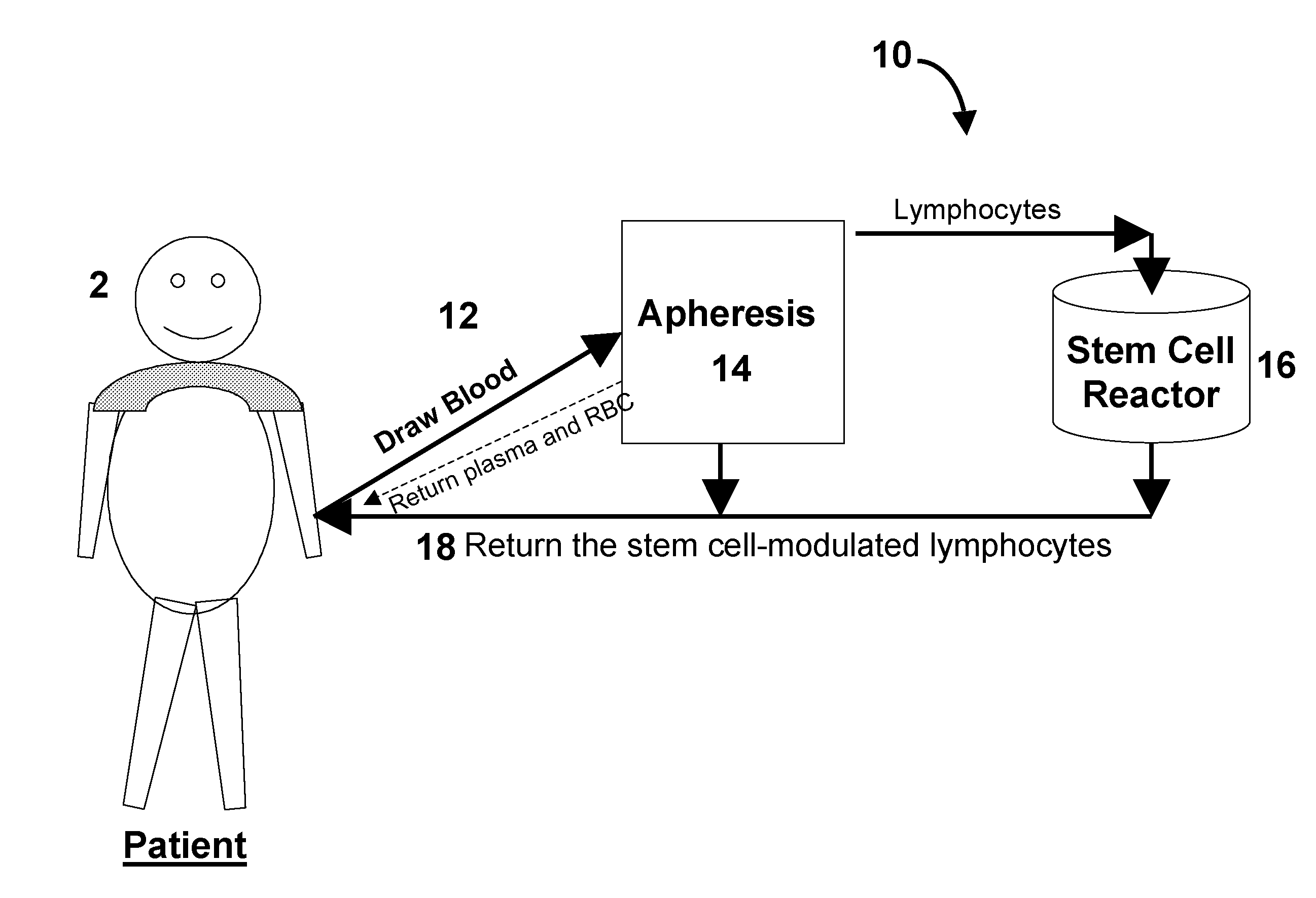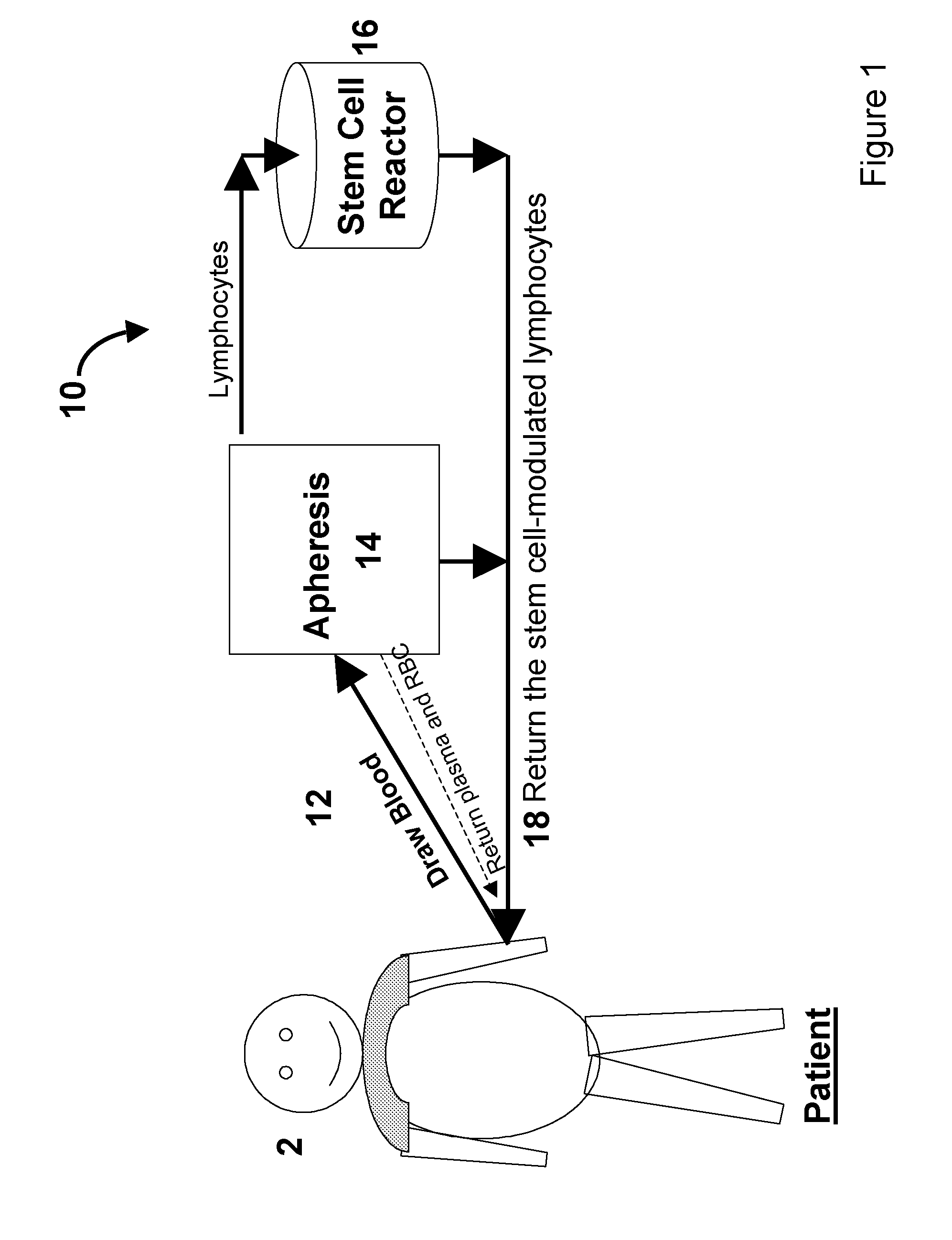Stem Cell Immune Modulation Methods of Use and Apparatus
a technology of immune modulation and stem cells, applied in the field of stem cell immune modulation, can solve the problems of limiting the practical application, limiting the availability and practical usefulness of es cells, and affecting the effect of autoimmune regulation
- Summary
- Abstract
- Description
- Claims
- Application Information
AI Technical Summary
Benefits of technology
Problems solved by technology
Method used
Image
Examples
example 1
Methods and Materials
[0118]Female NOD / LtJ mice, aged 5-6 weeks, were purchased from Jackson Laboratories (Bar Harbor, Me.) and maintained under pathogen-free conditions at the University of Illinois at Chicago. Blood glucose levels were monitored using an Ascensia ELITE glucometer (Bayer Corporation, Elkhart, Ind.) between 9 and 11 A.M. under nonfasting conditions. Female diabetic NOD / LtJ mice (at 24-28 weeks of age) with spontaneously-developed autoimmune diabetes as confirmed by weight loss, polyuria, and nonfasting blood glucose levels >250 mg / dL for at least 2 consecutive days were used for treatment, according to a protocol approved by the Animal Care Committee (ACC) of University of Illinois at Chicago.
Co-Cultures
[0119]Human umbilical cord blood (60-120 ml / unit / bag) was purchased from Life-Source Blood Services (Glenview, Ill.), which were derived from healthy donors. Application of cord blood for our researching does not need the ethical approval from the University and sign ...
example 2
Regulation of Mouse Regulatory T Lymphocytes
[0129]To investigate the therapeutic potential of Tregs in T1D, we employed an experimental nonobese diabetic (NOD) mouse model. Initially, we tested the co-culture of CB-SC and NOD mouse spleen-derived lymphocytes and found that co-culture with CB-SC did not significantly stimulate the proliferation of mouse lymphocytes at different ratios of CB-SC:lymphocytes (1:5, 1:10 and 1:20) FIG. 4A, p=0.25, p=0.15, p=0.16 respectively), which is similar to the co-culture of CB-SC and human lymphocytes. Data represented mean±s.d. of four independent experiments.
[0130]Next, we analyzed co-cultures of CB-SC and mouse lymphocytes for the presence of Tregs including conventional CD44+CD25+ Treg and CD4+Foxp3+ Treg, and the CD4+CD62L+ Treg. We found no significant differences in CD4+CD25+ Treg and CD4+Foxp3+ Treg in total mouse spleen lymphocytes that were either cultured alone or with CB-SC. In contrast, the percentage of CD4+CD62L+ Treg was increased a...
example 3
[0137]CB-SC can modulate the function of CD4+CD62L+ Tregs leading to prevention and reversal of overt autoimmune-caused type 1 diabetes (T1D) in NOD mouse model. We examined the immune modulation of CB-SC on CD4+CD62L+ Tregs of T1D patients in the presence of mitogen PHA (FIG. 8A and FIG. 8B). Intra-cellular cytokine staining results demonstrated that IL-5 level was significantly down-regulated (p=0.007), whereas IL-10 and TGF-1 were up-regulated in CD4+CD62L+ Tregs after co-culture with CB-SC compared with control PHA treatment (p=0.0018 and p=0.019 respectively), consistent with those in NOD mouse CD4+CD62L+ Tregs. In contrast, the IL-4, IL-12, and IFN-expressions did not change following co-culture with CB-SC (FIG. 8A). Additionally, transcription factor Foxp3, a specific marker for Tregs, was also up-regulated 2.7 fold after treatment with PHA+CB-SC compared with control PHA treatment (FIG. 8B). Thus, these data indicate that CB-SC can modulate the CD4+...
PUM
| Property | Measurement | Unit |
|---|---|---|
| thickness | aaaaa | aaaaa |
| thickness | aaaaa | aaaaa |
| permeable | aaaaa | aaaaa |
Abstract
Description
Claims
Application Information
 Login to View More
Login to View More - R&D
- Intellectual Property
- Life Sciences
- Materials
- Tech Scout
- Unparalleled Data Quality
- Higher Quality Content
- 60% Fewer Hallucinations
Browse by: Latest US Patents, China's latest patents, Technical Efficacy Thesaurus, Application Domain, Technology Topic, Popular Technical Reports.
© 2025 PatSnap. All rights reserved.Legal|Privacy policy|Modern Slavery Act Transparency Statement|Sitemap|About US| Contact US: help@patsnap.com



